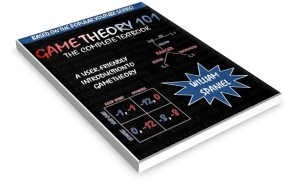We have seen games with incomplete information, and we have seen games with sequential moves. We have not yet seen a game with both at the same time. The intersection of the two is the focus of this unit. Solving these games requires the introduction of a new solution concept: perfect Bayesian equilibrium. The “perfect” part is a nod to subgame perfect equilibrium. The “Bayesian” part is a nod to the need to update beliefs. This lecture provides a quick introduction to the basics of it.
Takeaway Points
- A prefect Bayesian equilibrium (PBE) is a set of strategies and beliefs such that the strategies are sequentially rational given the players’ beliefs and the players update beliefs via Bayes rule wherever possible.
- The “beliefs” part of PBE is new. With all other equilibrium concepts, all you need to write out is the strategies the players select. New students commonly leave these out of an equilibrium description. Do not do that. Your answer will be wrong.
- Writing out the beliefs is important because the strategies must be optimal given the beliefs. Thus, we need to know what the beliefs players have to verify that the strategies are optimal. Moreover, the players must update their beliefs as the game goes on. As such, the beliefs they have are not always immediately obvious.
- Because Bayes’ rule is the correct way to update beliefs based on new information, the players must use it to form their posteriors.
- The “wherever possible” caveat arises because some moves may only arise off the equilibrium path of play. The probability of arriving at these is 0, and thus the denominator of Bayes’ rule is 0, and so the belief is undefined. In these cases, we must consider all possible beliefs that a player could adopt. This makes solving for PBE substantially more complicated than other types of equilibria we have seen.
- The requirement that strategies must be sequentially rational imposes subgame perfect equilibrium’s idea that threats made in equilibrium should be credible.
- Like with subgame perfect equilibrium, a PBE requires a description of strategies (and now also beliefs) both on and off the equilibrium path of play.
Broadly speaking, there are two types of games that we use perfect Bayesian equilibrium for: screening games and signaling games. Screening games have the uniformed actors move first. These are easier to solve for because the action that the player takes does not communicate information to the other player. Signaling games have the informed actor move first, which forces the uninformed actor to think about signals the informed actor might be sending with their move. These are more complicated, and we further divide PBE into three types: pooling equilibrium, separating equilibrium, and semi-separating or partially-pooling equilibrium. The rest of the unit will work through all of these.

